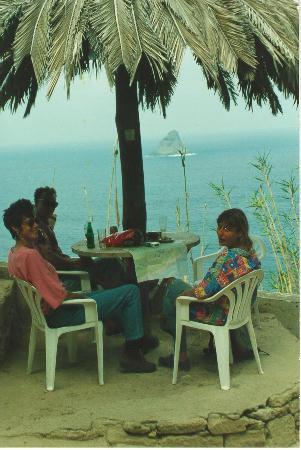
Chris, Sarah, Carole - view over Porto Santo harbour - click for larger pic (110k)
One of the attractions shown on the map we were given was a natural spring on the north coast. This turned out to be a major disappointment. The spring turned out, in fact, to be a tap set into a wall - located in a bar. After making the effort of getting there, we stopped for a drink and filled our water bottles from the "spring". The bar was virtually deserted, but had pleasant views over the sea.

Bar by the "famous spring", Porto Santo - click for larger pic (110k)
Many of the roads on Porto Santo were little more than tracks, and trailbikes would have been more suitable than Honda 50s. It was fun, though. I managed to ride through the only patch of mud on the island, getting myself, Carole and the bike extremely messy. I had to wash the bike before I could get my deposit back.
One one occasion we went swimming in the sea. It seemed pretty cold, but was probably not much worse than English summer temperatures. On another occasion we climbed up one of the cliffs - Carole is an experienced rock climber, but I found the crumbly hillside quite unnerving.
After finding the best club of our trip in Cascais, we found the worst one in Porto Santo. It was called Challenger. Sarah and Carole had got all dolled up in their little black dresses, and even Chris and I had made an effort to look a bit smart, but the place was grim and almost deserted. We didn't stay long.

Artwork on the wall, Porto Santo - click for larger pic (110k)
Porto Santo is one of those places, like Funchal and Horta, where it is traditional for yachties to do a painting on the harbour wall - and this we duly did.
After a few days we felt we were ready to move on, but the winds were strong and in the wrong direction. Eventually there was a lull, and we set off with at least half a dozen other boats for Madeira. Once we were out of the lee of the island, the wind hit us - about 25 knots right on the nose - and almost everyone decided to turn back. I think one boat carried on, and we heard later that they had a pretty rough time of it.
The following day it was virtually calm, although there were still confused swells from the week or so of strong winds. We motor-sailed uneventfully to Funchal, Madeira, and anchored in the harbour.
Madeira is a stunningly beautiful island, and I would dearly love to go back there. But not by boat. Funchal is a seriously unsatisfactory harbour. The harbour is wide open through at least 90 degrees, and if the wind and waves are from that quadrant it is virtually untenable. Also, the holding seems unpredictable. Sometimes, your anchor will drag - sometimes it will be virtually inextricable. There is a marina and, in view of the weather, we put the boats in there for a few days so we could hire a car and see the island. This was after seeing two boats smashed against a steel barge when the wind got up and their anchors dragged.
The marina itself was not great, with visiting boats moored in trots about seven deep from the harbour wall - tough on the inside boats. We were quite used to this sort of thing from the south coast of England - Poole, Weymouth and so on. But we were very surprised how many smart and expensive boats didn't have nearly enough fenders and warps to moor safely.
Madeira doesn't have much in the way of beaches, so it doesn't attract the sort of holiday crowd you get in the resotrs of Spain or the Canaries. But it does have the most stunning landscapes and vistas, and a greater profusion of exotic plant life than I have ever seen anywhere. Sarah, Carole and I hired a car for two days and thouroughly enjoyed touring the island. It would be a perfect destination for a hiking holiday, as it is crisscrossed by a remarkable network of levadas (artificial watercourses) which provide excellent walking.
After returning the hire car we moved back out to anchor, where we tossed around uncomfortably for a few days before setting off. Eric and Toby arrived in White Bread. They had had a bad trip with engine and electrical problems on top of the adverse conditions, and they looked shattered, so we opened a few cartons of wine to cheer them up. It was also in Funchal that we met Nick on Kylie. He was single-handed on a 26 footer, and he looked lonely, so we attracted his attention and waved a can of beer in the air. He was over like a shot. Nick became a very good friend. He is short but tough, and an enormously reourceful and capable sailor. Kylie herself is a well known boat, a Contessa 26 whose previous owner had done several transatlantics, and had written some good articles in the yachting press.
After about a week in Madeira, we set off in company with Idefix, White Bread and Kylie for the Canaries, another leg of 300 miles or so.



